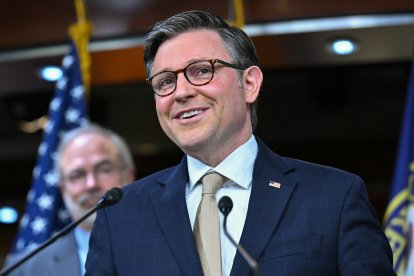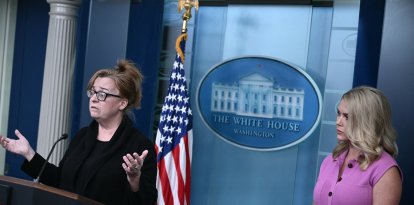House passes Trump and Johnson's proposal to avoid government shutdown
The Continuing Resolution will now head to the Senate, where it must pass by Friday, March 14, to avoid a shutdown.

Johnson on Capitol Hill/ Roberto Schmidt.
House Republicans passed their bill to avert the government shutdown. The legislation, in these cases called a Continuing Resolution (CR), had the backing of Donald Trump and Mike Johnson. It will now head to the Senate, where it must be passed by Friday, March 14, to avoid a shutdown.
With the lone opposing Republican being Thomas Massie (R-Ky.), all Republicans united behind the legislation, which passed Tuesday with a 217-213 vote. In turn, Rep. Jared Golden (D-Maine) was the only Democrat to vote with the majority.
The White House bet heavily on this bill, with President Trump making several phone calls to convince the most skeptical Republicans. In turn, Vice President J.D. Vance teamed up with Office of Management and Budget Director Russell Vought to ensure as little Republican opposition in the vote as possible.
'Congressional Republicans will stop at nothing to deliver on the mandate given by the American people'
Mike Johnson was quick to celebrate the outcome of the vote on X, where he claimed that Democrats are moving further and further away from interest of citizens.
"For years, House Democrats have railed against government shutdowns, but they suddenly changed their tune when President Trump returned to office. Their falsehoods and misinformation campaigns are a desperate attempt to distract from their own failures. Despite these tactics, President Trump and Congressional Republicans will stop at nothing to deliver on the mandate given by the American people," the Louisiana Republican said.
"In a shameful display of coordinated political theater, Democrats are willing to run out the clock on funding the government in a failed attempt to block the America First agenda. Now it’s decision time for Senate Democrats: cast a vote to keep the government open or be responsible for shutting it down," the House speaker said.
">Today, House Republicans stood for the American people and voted to maintain funding the paychecks for our troops, the agents who secure our borders, the TSA workers responsible for safe air travel, as well as the healthcare and benefits for veterans, and essential services and…
— Speaker Mike Johnson (@SpeakerJohnson) March 11, 2025
What's in the Republican legislation to avoid a government shutdown?
Among other things, the legislation backed by Trump and Johnson to avoid a government shutdown would do the following:
- Keep the government funded through Sept. 30
- Cut $20 billion to IRS enforcement
- Cut government spending by about $7 billion from FY 2024 levels
- Cut about $13 billion in non-defense discretionary spending across all federal departments
- Add $6 billion to the defense budget
- Force the city of Washington, D.C., to return to its 2024 budget
The legislation involves only discretionary spending, but not mandatory spending. The latter accounted for 40% of the spending increase in the last fiscal year and include Social Security, Medicare and Medicaid, programs that would not suffer cuts under this Republican proposal.
By focusing on discretionary spending, i.e., non-mandatory spending, Elon Musk and the Department of Government Efficiency (DOGE) will have more leeway over how that money is spent.
What is the government shutdown and what are its consequences?
In this case, the deadline remained March 14 because that is what lawmakers decided in the last CR passed in 2024.
The logic comes from the Constitution, specifically Article 1, Section 9: "No Money shall be drawn from the Treasury but in Consequence of Appropriations made by Law, and a regular Statement and Account of the Receipts and expenditures of all public Money shall be published from time to time."
Once closure is reached, certain agencies directly cease to function. They may be all, some or one in particular. Their employees cannot work and their pay is withheld until lawmakers agree on Capitol Hill.
The United States was completely unaware of this scenario until well into the 20th century, when the first government shutdown took place in 1980. Jimmy Carter was the first president to be in charge during this situation, which on that occasion lasted a little over 24 hours. The shutdown was repeated in 1982 (twice), 1983, 1984 (twice), 1986, 1987, 1990, 1990, 1995 (twice), 2013, 2018 and 2019.
Counting 1980, on the first five occasions, Democrats controlled the House of Representatives, which is usually in charge of pushing through the Appropriations Bill. Ronald Reagan was the president who witnessed the most government shutdowns, at eight between 1981 and 1989.
The latest, coincidentally the longest, was in 2019, when it took 35 days for government operations to return to normal. An estimated 800,000 public employees did not receive their pay during that period of time.
RECOMMENDATION





















